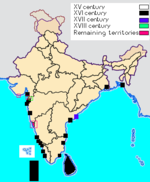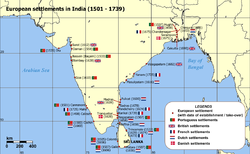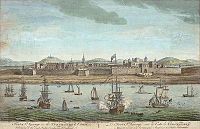- Colonial India
-
Colonial India 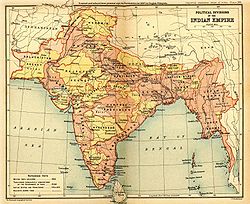
British Indian EmpireColonial India Portuguese India 1510–1961 Dutch India 1605–1825 Danish India 1620–1869 French India 1759–1954 British India 1613–1947 East India Company 1612–1757 Company rule in India 1757–1857 British Raj 1858–1947 British rule in Burma 1824–1942 Princely states 1765–1947/48 Partition of India 1947 Colonial India refers to areas of the Indian Subcontinent under the control of European colonial powers, through trade and conquest. The first European power to arrive in India was the army of Alexander the Great in 327–326 BC. The satraps he established in the north west of the subcontinent quickly crumbled after he left. Later, trade was carried between Indian states and the Roman Empire by Graeco-Roman and Egyptian sailors who reached India by ship through the Red and Arabian Seas. The spice trade between India and Europe was one of the main drivers of the world economy[1] and was the main catalyst for the Age of Discovery.[2]
The search for the wealth and prosperity of India led to the accidental discovery of the Americas by Christopher Columbus in 1492. However, it was also near the end of the 15th century that Portuguese sailor Vasco da Gama became the first European to re-establish direct trade links with India since Roman times, by being the first to arrive by circumnavigating Africa. Having arrived in Calicut, which by then was one of the major trading ports of the eastern world,[3] he obtained permission to trade in the city from Saamoothiri Rajah.
Trading rivalries brought other European powers to India. The Dutch, English, French and Danes established trading posts in India in the early 17th century. As the Mughal Empire disintegrated in the early 18th century and then the Maratha Empire became weakened after the third battle of Panipat, the relatively weak and unstable Indian states which emerged were increasingly open to manipulation by the Europeans through dependent "friendly" Indian rulers.
In the later 18th century the British and French entered into intense struggles for dominance through proxy Indian rulers and also by direct military intervention. The defeat of the redoubtable Indian ruler Tipu Sultan in 1799 marginalized French influence. This was followed by a rapid expansion of British power through the greater part of the subcontinent in the early 19th century. By the middle of the century, the British had already gained direct or indirect control over almost all of India. British India contained the most populous and valuable provinces of the British Empire and thus became known as "the jewel in the British crown".
Contents
European contact
Main article: Portuguese IndiaVasco da Gama lands at Calicut, May 20, 1498.
Long after the decline of the Roman Empire's sea-borne trade with India, the Portuguese were the next Europeans to arrive for the purpose of trade, first arriving in May 1498. The closing of the traditional trade routes in western Asia by the Ottomans and rivalry with the Italian states sent Portugal in search of an alternate sea route to India. The first successful voyage to India was by Vasco da Gama in 1498, when he arrived in Calicut, now in Kerala. Having arrived in Calicut he obtained from Saamoothiri Rajah permission to trade in the city. The navigator was received with traditional hospitality, but an interview with the Saamoothiri (Zamorin) failed to produce any definitive results. Vasco da Gama requested permission to leave a factor behind in charge of the merchandise he could not sell; his request was refused, and the king insisted da Gama should pay customs duty, like any other trader, which strained relations between the two.
The colonial era in India began in 1502, when the Portuguese Empire established the first European trading centre at Kollam, Kerala. In 1505 the King of Portugal appointed Dom Francisco de Almeida as the first Portuguese viceroy in India, followed in 1509 by Dom Afonso de Albuquerque. In 1510 Albuquerque established an important trading presence in Goa by conquering the city, which had been dominated by Muslims. He inaugurated the policy of marrying Portuguese soldiers and sailors with local Indian girls, the consequence of which was a great miscegenation in Goa and other Portuguese territories in Asia. Another feature of the Portuguese presence in India was their will to evangelize and promote Catholicism. In this, the Jesuits played a fundamental role, and to this day the Jesuit missionary Saint Francis Xavier is revered among the Catholics of India.
The Portuguese established a chain of outposts along India's west coast and on the island of Ceylon in the early 16th century. They built the St. Angelo Fort at Kannur to guard their possessions in North Malabar.[4] Goa was their prized possession and the seat of Portugal's viceroy. Portugal's northern province included settlements at Daman, Diu, Chaul, Baçaim, Salsette, and Mumbai. The rest of the northern province, with the exception of Daman and Diu, was lost to the Maratha Empire in the early 18th century.
In 1661 Portugal was at war against Spain and needed support from England, which led to the signing of the agreement for a marriage between Princess Catherine of Portugal and Charles II of England, with a dowry that included the city of Bombay. This was the beginning of the English presence in India.
Dutch
Main article: Dutch IndiaThe Dutch East India Company established trading posts on different parts along the Indian coast. For some while, they controlled the Malabar southwest coast (Cranganore/Cranganor/Kodungallor, Cochin de Cima/Pallipuram, Cochin, Cochin de Baixo/Santa Cruz, Quilon (Coylan), Cannanore, Kundapura, Kayankulam, Ponnani) and the Coromandel southeastern coast (Golkonda, Bimilipatnam, Jaggernaikpoeram/Kakinada, Palikol, Pulicat, Porto Novo/Parangippettai, Negapatnam) and Surat (1616–1795). They conquered Ceylon from the Portuguese. The Dutch also established trading stations in Travancore and coastal Tamil Nadu as well as at Rajshahi in present-day Bangladesh, Pipely, Hugli-Chinsura, and Murshidabad in present-day West Bengal, Balasore (Baleshwar or Bellasoor) in Orissa, and Ava, Arakan, and Syriam in present-day Myanmar (Burma). Ceylon was lost at the Congress of Vienna in the aftermath of the Napoleonic Wars, where the Dutch having fallen subject to France, saw their colonies raided by Britain. The Dutch later became less involved in India, as they had the Dutch East Indies (now Indonesia) as their prized possession.
English and British India
Main articles: English colonial empire and British IndiaRivalry with the Netherlands
At the end of the 16th century, England and the United Netherlands began to challenge Portugal's monopoly of trade with Asia, forming private joint-stock companies to finance the voyages—the English, later British, and the Dutch East India Companies, which were chartered in 1600 and 1602 respectively. The primary aim of these companies was to tap into the lucrative spice trade, and they focused their efforts on the areas of production, the Indonesian archipelago and especially the "Spice Islands", and on India as an important market for the trade. The close proximity of London and Amsterdam across the North Sea, and the intense rivalry between England and the Netherlands, inevitably led to conflict between the two companies, with the Dutch gaining the upper hand in the Moluccas (previously a Portuguese stronghold) after the withdrawal of the English in 1622, but with the English enjoying more success in India, at Surat, after the establishment of a factory in 1613.
The Netherlands' more advanced financial system[5] and the three Anglo-Dutch Wars of the 17th century left the Dutch as the dominant naval and trading power in Asia. Hostilities ceased after the Glorious Revolution of 1688, when the Dutch William of Orange ascended the English throne, bringing peace between the Netherlands and England. A deal between the two nations left the more valuable spice trade of the Indonesian archipelago to the Netherlands and the textiles industry of India to England, but textiles overtook spices in terms of profitability, so that by 1720, in terms of sales, the English company had overtaken the Dutch.[5] The English East India Company shifted its focus from Surat—a hub of the spice trade network—to Fort St. George.
East India Company
See also: Company rule in IndiaIn 1757 Mir Jafar, the commander in chief of the army of the Nawab of Bengal, along with Jagat Seth, Maharaja Krishna Nath, Umi Chand and some others, secretly connived with the British asking logistic support to overthrow the Nawab in return for trade grants. The British forces, whose sole duty until then was guarding their British East India Company property, were numerically inferior to the Bengali armed forces. At the Battle of Plassey on 23 June 1757, fought between the British under the command of Robert Clive and the Nawab, Mir Jafar's forces betrayed the Nawab and helped defeat him. Jafar was installed on the throne as a British subservient ruler.[6] The battle transformed British perspective as they realized their strength and potential to conquer smaller Indian kingdoms and marked the beginning of the imperial or colonial era.
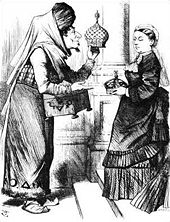 An 1876 political cartoon of Benjamin Disraeli (1804–1881) making Queen Victoria Empress of India. The caption was "New crowns for old ones!"
An 1876 political cartoon of Benjamin Disraeli (1804–1881) making Queen Victoria Empress of India. The caption was "New crowns for old ones!"
British policy in Asia during the 19th century was chiefly concerned with expanding and protecting its hold on India, viewed as its most important colony and the key to the rest of Asia.[7] The East India Company drove the expansion of the British Empire in Asia. The company's army had first joined forces with the Royal Navy during the Seven Years' War, and the two continued to cooperate in arenas outside India: the eviction of Napoleon from Egypt (1799), the capture of Java from the Netherlands (1811), the acquisition of Singapore (1819) and Malacca (1824), and the defeat of Burma (1826).[8]
From its base in India, the company had also been engaged in an increasingly profitable opium export trade to China since the 1730s. This trade, unlawful in China since it was outlawed by the Qing dynasty in 1729, helped reverse the trade imbalances resulting from the British imports of tea, which saw large outflows of silver from Britain to China. In 1839, the confiscation by the Chinese authorities at Canton of 20,000 chests of opium led Britain to attack China in the First Opium War, and the seizure by Britain of the island of Hong Kong, at that time a minor settlement.[9]
The British had direct or indirect control over all of present-day India before the middle of the 19th century. In 1857, a local rebellion by an army of sepoys escalated into the Rebellion of 1857, which took six months to suppress with heavy loss of life on both sides. This resistance, although short-lived, was triggered by British attempts to Westernise India.[10] As a result, the East India Company lost its powers of government and British India formally came under direct British rule, with an appointed governor-general administering India. The East India Company was dissolved the following year in 1858. A few years later, Queen Victoria took the title of Empress of India.[11].
India suffered a series of serious crop failures in the late 19th century, leading to widespread famines in which at least 10 million people died. The East India Company had failed to implement any coordinated policy to deal with the famines during its period of rule. This changed during the Raj, in which commissions were set up after each famine to investigate the causes and implement new policies, which took until the early 1900s to have an effect.[12]
The slow but momentous reform movement developed gradually into the Indian Independence Movement. During the years of World War I, the hitherto bourgeois "home-rule" movement was transformed into a popular mass movement by Mahatma Gandhi, a pacifist. Apart from Gandhi, other revolutionaries such as Shaheed Bhagat Singh, Chandrashekar Azad and Subhash Chandra Bose, were not against use of violence to oppose the British rule. The independence movement attained its objective with the independence of Pakistan and India on 14 August and 15 August 1947 respectively.
French
Main article: French IndiaFollowing the Portuguese, English, and Dutch, the French also established trading bases in India. Their first establishment was in Pondicherry on the Coromandel Coast in southeastern India in 1674. Subsequent French settlements were Chandernagore in Bengal, northeastern India in 1688, Yanam in Andhra Pradesh in 1723, Mahe in 1725, and Karaikal in 1739. The French were constantly in conflict with the Dutch and later on mainly with the British in India. At the height of French power in the mid-18th century, the French occupied large areas of southern India and the area lying in today's northern Andhra Pradesh and Orissa. Between 1744 and 1761, the British and the French repeatedly attacked and conquered each other's forts and towns in southeastern India and in Bengal in the northeast. After some initial French successes, the British decisively defeated the French in Bengal in the Battle of Plassey in 1757 and in the southeast in 1761 in the Battle of Wandiwash, after which the British East India Company was the supreme military and political power in southern India as well as in Bengal. In the following decades it gradually increased the size of the territories under its control. The enclaves of Pondicherry, Karaikal, Yanam, Mahé and Chandernagore were returned to France in 1816 and were integrated with the Republic of India after its independence in 1947.
Danish
Main article: Danish IndiaDenmark was a minor colonial power to set foot in India. It established trading outposts in Tranquebar, Tamil Nadu (1620), Serampore, West Bengal (1755) and the Nicobar Islands (1750s). At one time, the main Danish and Swedish East Asia companies together imported more tea to Europe than the British did. Their outposts lost economic and strategic importance, and Tranquebar, the last Danish outpost, was sold to the British in 1845.
Other external powers
The Spanish were briefly given territorial rights to India by Pope Alexander VI on 25 September 1493 by the bull Dudum siquidem before these rights were removed by the Treaty of Tordesillas less than one year later. The Japanese briefly occupied the Andaman and Nicobar Islands during World War II.
Wars
The wars that took place involving the British East India Company or British India during the Colonial era:
- Anglo-Mysore Wars
- First Anglo-Maratha War
- Second Anglo-Maratha War
- Third Anglo-Maratha War
- First Anglo-Sikh War
- Second Anglo-Sikh War
- Gurkha War
- Burmese Wars
- First Opium War
- Second Opium War
- First Anglo-Afghan War
- Second Anglo-Afghan War
- Third Anglo-Afghan War
- World War I, see List of Indian divisions in World War I, Bombardment of Madras
- World War II
See also
- Maratha Empire
- Sikh Empire
- Macaulayism
- List of Indian Princely States
- Hyderabad State
- Rajput States
- Kingdom of Calicut
- Kingdom of Mysore
- Kingdom of Travancore
Notes
- ^ Corn & Glasserman 1999: Prologue
- ^ Donkin, Robin A. (August 2003). Between East and West: The Moluccas and the Traffic in Spices Up to the Arrival of Europeans. Diane Publishing Company. ISBN 0871692481.
- ^ Time. 2001-08-20. http://www.time.com/time/asia/features/journey2001/india.html.[dead link]
- ^ Nandakumar Koroth, History of Forts in North Malabar.
- ^ a b Ferguson 2004, p. 19.
- ^ Wolpert, Stanley (1989). A New History of India (3rd ed.), p. 180. Oxford University Press.
- ^ Olson, p. 478.
- ^ Porter, p. 401.
- ^ Olson, p. 293.
- ^ Olson, p.567
- ^ Olson, p.568
- ^ Marshall, pp. 133–34.
References
- Brian, Mac Arthur (1996) The Penguin Book of Historic Speeches ed. Penguin Books.
- Kachru, Braj (1983) The Indainization of English, Oxford: Oxford University Press.
- Moss, Peter (1999) Oxford History for Pakistan, a revised and expanded version of Oxford History Project Book Three; Oxford: Oxford University Press.
- Mubarak Ali, Dr, (Oct.5, 2008) 'Different Strokes' (pub) Sunday, Magazine, The daily Dawn, Karachi.
- Ferguson, Niall (2004). Empire. Basic Books. ISBN 0465023290. http://books.google.com/books?id=luSjXeSByHEC. Retrieved 2009-07-22.
- Olson, James (1996). Historical Dictionary of the British Empire. Greenwood Publishing Group. ISBN 031329366X. http://books.google.com/books?id=ol1bAAAACAAJ. Retrieved 2009-07-22.
- Marshall, PJ (1996). The Cambridge Illustrated History of the British Empire. Cambridge University Press. ISBN 0521002540. http://books.google.com/books?id=S2EXN8JTwAEC. Retrieved 2009-07-22.
- Porter, Andrew (1998). The Nineteenth Century, The Oxford History of the British Empire Volume III. Oxford University Press. ISBN 0199246785. http://books.google.com/books?id=oo3F2X8IDeEC. Retrieved 2009-07-22.
Further reading
- Andrada (undated). The Life of Dom John de Castro: The Fourth Vice Roy of India. Jacinto Freire de Andrada. Translated into English by Peter Wyche. (1664). Henry Herrington, New Exchange, London. Facsimilie edition (1994) AES Reprint, New Delhi. ISBN 81-206-0900-X.
- Herbert, William; William Nichelson, Samuel Dunn (1791). A New Directory for the East-Indies. Gilbert & Wright, London. http://www.archive.org/stream/newdirectoryfore00herb#page/n7/mode/2up.
External links
- List of archaeological remains of Dutch, Danish and Portuguese India settlements
- gateway.for.india: British history
Categories:- European rule in India
- European colonisation in Asia
Wikimedia Foundation. 2010.

